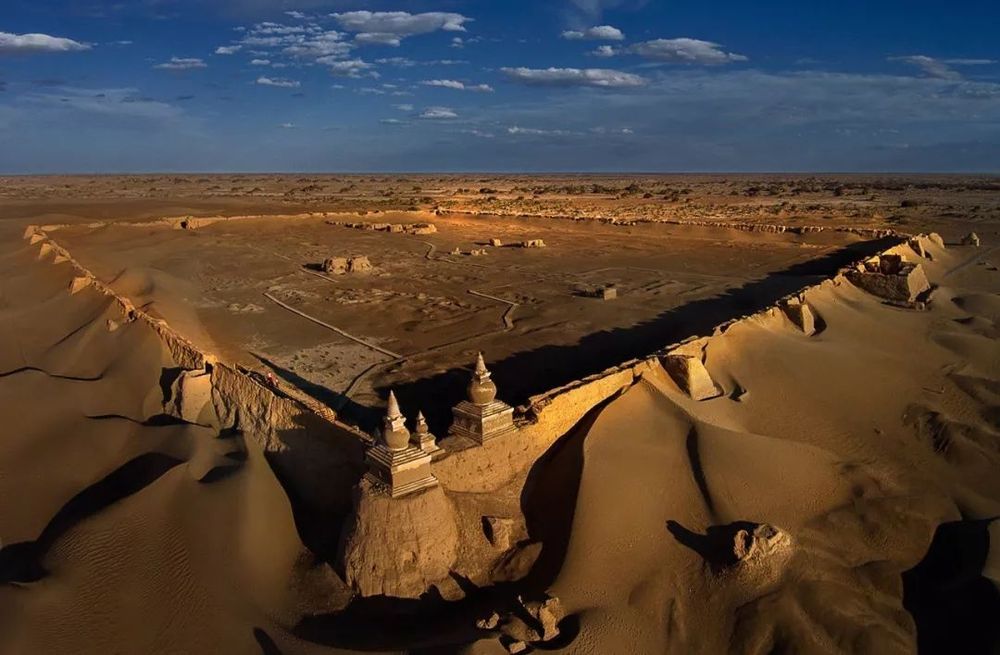In the westernmost banner of Inner Mongolia, in the middle of the Gobi Desert, there once stood a prosperous kingdom. It was a center of religious learning, of art and a trading hub. But all that remains now are the crumbling ramparts that once protected the city, a few shattered mud buildings, and scattered sun-bleached bones.

Photo: Twitter
Khara-Khoto, or “black city” in Mongolian was founded in 1032 AD as the capital of the Western Xia Dynasty (1038–1227) and soon rose to become a thriving trade hub. The city was captured by Genghis Kahn in 1226, but instead of laying to waste as the Khan's Golden Horde usually did to captured cities, Khara-Khoto actually flourished under Mongol rule. During Kublai Khan's time, the city expanded to three times its original size, and was even mentioned by Marco Polo in his travelogue by its Tangut name of Etzina:
When you leave the city of Campichu you ride for twelve days, and then reach a city called Etzina, which is towards the north on the verge of the Sandy Desert; it belongs to the Province of Tangut. The people are Idolaters, and possess plenty of camels and cattle, and the country produces a number of good falcons, both Sakers and Lanners. The inhabitants live by their cultivation and their cattle, for they have no trade. At this city you must needs lay in victuals for forty days, because when you quit Etzina, you enter on a desert which extends forty days' journey to the north, and on which you meet with no habitation nor baiting-place.
Under the Mongols, the Tangut people were able to enjoy peaceful existence for nearly 150 years, until the Ming dynasty laid siege to the city in 1372. No one knows exactly how Khara-Khoto fell, but local legend states that the cunning Ming rulers diverted the Ejin River, the city's only water source, that flowed just outside the fortress thus denying the city’s troops and inhabitants of the life-giving elixir. As the Ming troops choked the city without ever needing to set foot inside of its walls, the people of Khara-Khoto realized that they must make a terrible choice: die of thirst, or face the Ming soldiers in combat.

Four of the five Yuan dynasty stupas sited on top of the northwest corner of the walls of Kharakhoto. Photo: Yeoh Thean Kheng/Flickr
A Mongol military general named Khara Bator supposedly became so crazed by this plight that he murdered his wife and children before committing suicide. There is another version of the rumor that holds that Khara Bator made a breach in the northwestern corner of the city wall and escaped through it. When the Ming soldiers finally attacked, they slaughtered not only the remaining population but all the cattle and horses. After this defeat, Khara-Khoto was abandoned and fell into ruins.
The site was rediscovered in the early 20th century by a Mongol-Sichuan expedition under the command of Russian explorer Pyotr Kuzmich Kozlov. During its initial excavation, the expedition uncovered over 2,000 books, scrolls and manuscripts in the Tangut language. These treasures were sent back to St. Petersburg along with Buddhist statues, texts, and woodcuts that were found in a stupa outside of the city walls. Further excavation produced many thousand more manuscripts, books, as well as daily items, production instruments and religious art. Many of these books and xylographs formed the basis for research of the Tangut language, written in Tangut script in subsequent years.
Now all that remains of this great city are 30-feet-tall ramparts, a few 40-feet high pagodas, and what appears to be a mosque just outside the city walls, indicating that there were Muslims among the people that were ruled by the Tangut.

The mosque at the southeast corner of Kharakhoto, circa 1914. Photo: Aurel Stein/Wikimedia

Stacks of mud bricks for repair work outside the south wall of Kharakhoto. Photo: BabelStone/Wikimedia

Photo: Fandorine1959/Wikimedia












Comments
Post a Comment